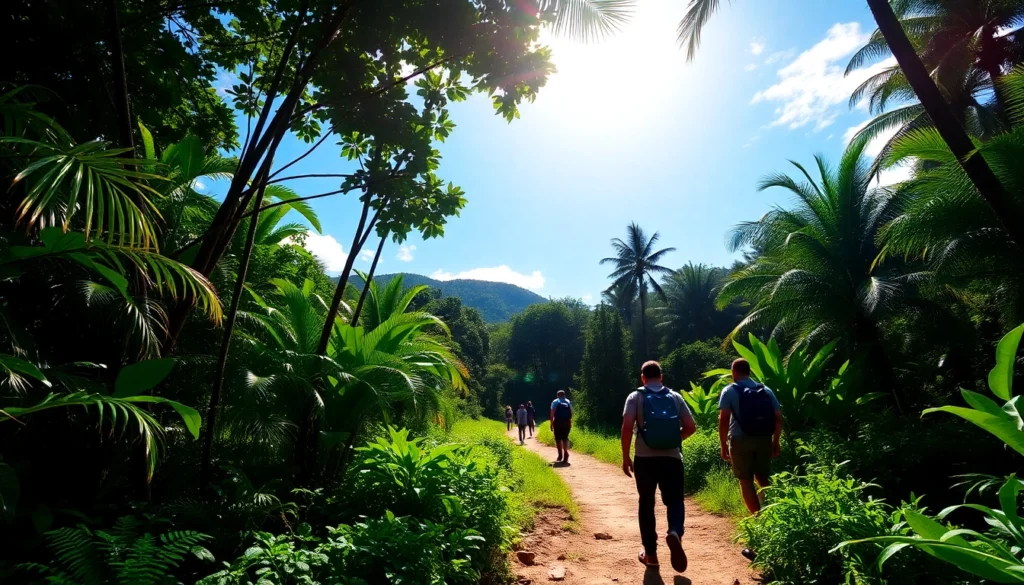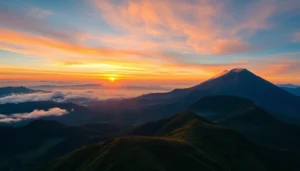Panduan Lengkap Hiking di Indonesia: Tips, Destinasi, dan Manfaat Kesehatannya

Understanding Hiking: An In-Depth Exploration of One of the Most Popular Outdoor Activities
Nature has always been an essential part of human life, serving as a source of recreation, inspiration, and physical activity. Among the many ways to connect with the outdoors, hiking stands out as a timeless activity that combines adventure, health benefits, and cultural exploration. Whether you’re a seasoned trekker or just beginning to discover outdoor pursuits, understanding the nuances of hiking—its definitions, differences from related activities like trekking, and its evolving role in modern lifestyles—is crucial. This comprehensive guide aims to deepen your knowledge about hiking, particularly in the Indonesian context, and equip you with practical tips to enhance your experience.
Apa Itu Hiking dan Perbedaan Utamanya dengan Trekking
Definisi hiking dan sejarah perkembangannya
Hiking, derived from the word “hike,” refers to long, vigorous walks through natural terrains on trail systems or footpaths. This activity emphasizes enjoyment of the scenery, physical exercise, and mental rejuvenation. Historically, hiking emerged centuries ago as a means for Europeans to access scenic countryside and establish a leisure activity beyond daily survival chores. By the eighteenth century, it had become popular among the European aristocracy as an activity for health and social interaction.
Throughout the 20th century, hiking gained global popularity with the advent of organized national parks, outdoor recreation movements, and improvements in infrastructure. It evolved from a necessity into a recreational pursuit accessible to diverse demographics, emphasizing mental well-being and physical health. Today, hiking is not only a fitness activity but also a cultural phenomenon, with numerous trails, guide services, and hiking communities worldwide, including Indonesia, which boasts an array of scenic trails suitable for enthusiasts of all levels.
Ciri khas kegiatan hiking di Indonesia
Indonesia offers a uniquely vibrant hiking landscape, distinguished by its rich biodiversity, volcanic terrains, and cultural diversity. The activity commonly involves ascending mountains such as Gunung Rinjani, exploring lush rainforests like Taman Nasional Gunung Leuser, or traversing scenic coastal routes. In Indonesia, hiking is deeply intertwined with local traditions, with many trails passing through indigenous villages, offering hikers authentic cultural experiences.
Key features include:
- Accessible trails from beginner-friendly walks to challenging multi-day hikes.
- Integration of cultural visits, especially in regions like Bali, Flores, and Sulawesi.
- Use of local guides who are knowledgeable about terrain, flora, fauna, and local customs.
- Environmental appreciation, emphasizing the preservation of Indonesia’s delicate ecosystems.
Perbedaan hiking dan trekking: tingkat kesulitan dan durasi
While often used interchangeably, hiking and trekking are distinct in terms of difficulty and duration. Hiking generally describes short to moderate walks—ranging from a few hours to a day—on well-maintained trails with relatively manageable terrains. It emphasizes leisure and scenic enjoyment.
Trekking, on the other hand, involves more intense, often multi-day journeys through remote, rugged, mountainous, or wilderness areas. It requires more physical preparation, specialized equipment, and logistical planning, as trekkers usually need to carry supplies, or plan for camping and resupply points. In Indonesia, trekking often includes traversing volcanic landscapes or dense rainforests, demanding higher endurance and technical skills.
Summary: Hiking is accessible and suitable for casual outdoor enthusiasts, while trekking caters to adventure seekers seeking greater challenges and longer explorations.
Manfaat Kesehatan dan Psikologis dari Hiking di Alam Terbuka
Manfaat fisik: meningkatkan stamina dan kekuatan otot
Engaging regularly in hiking significantly improves physical health. Walking uphill or across uneven terrains engages multiple muscle groups, strengthening legs, core, and even upper body when using trekking poles. It enhances cardiovascular endurance, promotes calorie burning, and increases stamina over time. A study by the U.S. National Park Service emphasizes that consistent hiking can reduce risks associated with heart disease, obesity, and hypertension. In Indonesia’s diverse terrains, such as Mount Rinjani or Kerinci Seblat National Park, these physical challenges enhance overall fitness and muscular strength.
Manfaat mental: mengurangi stres dan meningkatkan kebahagiaan
Beyond physical benefits, hiking offers substantial mental health improvements. Fresh air, natural scenery, and physical activity combine to reduce stress hormone levels, combat anxiety, and lift mood. Nature exposure is linked to decreased symptoms of depression and enhanced cognitive function. The concept of “nature therapy” or ecotherapy has gained recognition globally, including in Indonesia, as a means for psychological relief. Hikers often describe a sense of achievement, clarity, and emotional well-being following extended outdoor adventures.
Hiking sebagai bagian dari gaya hidup sehat di Indonesia
In recent years, hiking has become a vital component of Indonesia’s healthy lifestyle movement. Urban centers like Jakarta and Surabaya witness growing communities engaging in mountain hikes, forest treks, and coastal walks. Local initiatives promote outdoor activity as a counterbalance to sedentary routines, emphasizing physical fitness, social connection, and environmental stewardship. This movement aligns with global trends but also emphasizes Indonesian values of harmony with nature and cultural preservation.
Tips & Persiapan Mendaki yang Aman dan Nyaman
Pemilihan perlengkapan hiking dan alas kaki yang tepat
Proper equipment is essential for a safe and enjoyable hike. Selecting the right footwear, such as sturdy hiking boots with ankle support and slip-resistant soles, minimizes injuries. Clothing should be layered, moisture-wicking, and appropriate to weather conditions, especially in Indonesia where climate variability is high. Essentials include a durable backpack, hydration system, navigation tools (maps, compass, GPS), first aid kit, and sun protection. Investing in quality gear not only enhances performance but also ensures durability during demanding treks.
Perencanaan rute dan prediksi cuaca sebelum hiking
Preparation begins with thorough route planning. Use topographical maps and local guides to identify trail difficulty, distance, and points of interest. Predictive weather analysis is crucial, particularly in Indonesia’s monsoon seasons, which can cause intense rainfall, landslides, or flash floods. Consulting local authorities or park services for updated conditions provides safety assurance. Planning for contingency routes and emergency exits is equally important.
Etika dan pelestarian alam saat melakukan aktivitas hiking
Hiking carries a responsibility to preserve the environment. Principles include “Leave No Trace”—packing out all trash, avoiding damage to vegetation, and staying on designated trails to prevent erosion. Respect local communities, cultural sites, and wildlife. In Indonesia, where ecosystems are fragile and endemic species abound, responsible hiking contributes positively to conservation efforts and sustainable tourism.
Destinasi Hiking Terpopuler di Indonesia dan Tips Memilihnya
Gunung Rinjani dan keindahan alamnya
Mount Rinjani, Indonesia’s second-highest volcano, attracts thousands of hikers annually. Its challenging summit, stunning crater lake Segara Anak, and diverse flora and fauna make it a premier destination. Optimal times to hike are during the dry season (April to October). Preparation includes physical training, booking certified guides, and acclimatization periods due to high elevation gains. Rinjani offers both beginner-friendly treks and advanced routes.
Cerita hiking di Kawasan Bromo dan sekitarnya
The Bromo Tengger Semeru National Park in East Java features the iconic Mount Bromo, known for its otherworldly sunrise views and volcanic landscape. The hike from the parking area to the viewpoint is accessible for most, but for a more immersive experience, multi-day hikes across the surrounding craters and forests are popular. Visitors should consider weather conditions, as fog and volcanic ash can impact visibility, and always respect safety guidelines.
Wisata hiking di hutan tropis Kalimantan dan Papua
For wilderness explorers, Kalimantan’s Tanjung Puting or Papua’s Lorentz National Park provide dense rainforests, unique biodiversity, and cultural encounters. These regions demand higher technical skill and local guides’ assistance. Trekking options include wildlife observation, river crossings, and mountain ascents. Proper planning is vital, including permits, guides, and emergency protocols, to ensure safety amidst remote and pristine environments.
Memulai Karir dan Komunitas Hiking di Indonesia
Menemukan komunitas hiking lokal dan nasional
Joining hiking communities enhances experience, safety, and cultural understanding. Indonesia has an active network of clubs and online groups such as Indonesian Mountain Community (IMC) and others on social media platforms. These groups organize regular events, share trail information, and foster camaraderie among outdoor enthusiasts.
Peluang mengikuti pelatihan dan tour guide profesional
Developing professional skills through certified training programs is a pathway for those interested in guiding others. The Ministry of Tourism and local adventure companies often offer courses on outdoor safety, navigation, environmental conservation, and first aid, equipping guides with skills to lead responsible hikes and contribute to eco-tourism growth.
Membuat konten dan berbagi pengalaman hiking untuk inspirasi
Sharing stories, photos, and videos of hiking adventures inspires others to explore. Building a blog, YouTube channel, or social media presence fosters a community of outdoor lovers while promoting sustainable tourism. Tips include authentic storytelling, highlighting local culture, and emphasizing safety and ecological responsibility.




